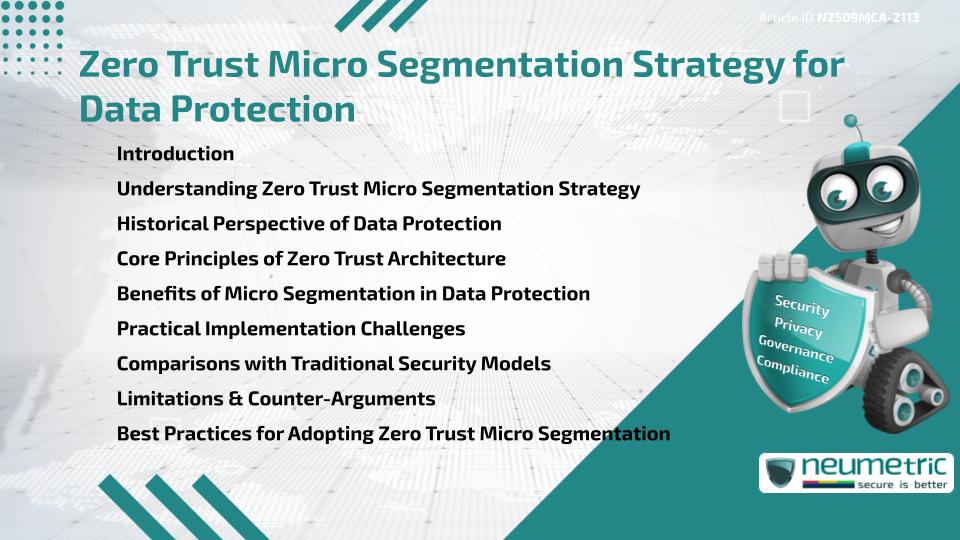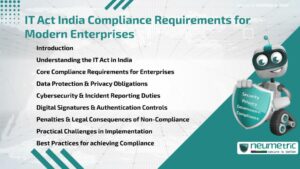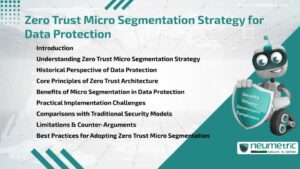Table of Contents
ToggleIntroduction
A zero trust micro segmentation strategy is a modern approach to Data Protection that eliminates implicit trust in networks & enforces strict Access Controls at every level. Unlike perimeter-based models, this strategy breaks down networks into smaller, manageable zones, each requiring authentication & authorisation. This reduces the attack surface, limits lateral movement of Threats & enhances compliance with Data Security regulations. Organisations increasingly adopt this model to safeguard sensitive assets, secure cloud workloads & reduce the Risk of breaches in hybrid IT environments.
Understanding Zero Trust Micro Segmentation Strategy
The zero trust micro segmentation strategy combines two essential ideas: the zero trust Framework & network segmentation. Zero trust means that no user, device or application is trusted by default, even if it operates inside the network. Micro segmentation involves dividing networks into small segments or zones, each with strict access rules. Together, they create a layered defense that protects sensitive workloads & ensures visibility into traffic patterns.
For example, instead of allowing Employees broad access to multiple databases, micro segmentation restricts each User to the specific resources they need. This way, even if one segment is compromised, the breach cannot spread across the entire system.
Historical Perspective of Data Protection
Data Protection has evolved significantly over the past few decades. Early approaches relied on firewalls & antivirus tools to defend against Threats. In the 1990s & early 2000s, perimeter security became the Standard model, focusing on building strong defenses at the network edge. However, with the rise of cloud computing, mobile devices & remote work, traditional boundaries weakened. Attackers learned to exploit lateral movement once inside the network, making perimeter-based defenses insufficient.
The zero trust micro segmentation strategy emerged as a response to these limitations, providing security not just at the edge but across every part of the network.
Core Principles of Zero Trust Architecture
The zero trust Framework rests on several Core Principles that support micro segmentation:
- Never trust, always verify – Every request must be authenticated, regardless of where it originates.
- Least privilege access – Users & applications should only have the minimum access required to perform their tasks.
- Micro segmentation – Networks should be divided into isolated zones with strict access Policies.
- Continuous Monitoring – User behaviour or & traffic patterns must be observed in real time to detect anomalies.
These principles help Organisations reduce Risk & enforce compliance across multiple regulatory environments.
Benefits of Micro Segmentation in Data Protection
Implementing a zero trust micro segmentation strategy offers several advantages:
- Reduced attack surface – Segmenting workloads limits the spread of malware or ransomware.
- Enhanced visibility – Administrators gain a clearer view of traffic flow & potential Vulnerabilities.
- Improved compliance – Micro segmentation makes it easier to demonstrate regulatory alignment.
- Better control of hybrid environments – Organisations can secure both on-premises & cloud systems effectively.
By isolating sensitive workloads, companies protect critical applications & ensure resilience against sophisticated Cyber Threats.
Practical Implementation Challenges
While effective, adopting a zero trust micro segmentation strategy is not without difficulties. Some of the common challenges include:
- Complexity of redesigning existing network structures.
- Cost & resource requirements for deployment.
- Resistance from Employees due to stricter access Policies.
- Integration with legacy systems that lack native support for segmentation.
Organisations need to balance these hurdles with the potential long-term security & compliance benefits.
Comparisons with Traditional Security Models
Traditional models often rely on perimeter defenses, much like a castle with strong walls but vulnerable interiors. Once an attacker bypasses the wall, they have free movement. In contrast, the zero trust micro segmentation strategy is like building many smaller secure rooms within the castle. Even if one room is breached, the rest remain protected.
This comparison highlights why the zero trust model has gained traction as businesses adapt to distributed workforces & cloud-based operations.
Limitations & Counter-Arguments
Critics argue that implementing a zero trust micro segmentation strategy can lead to operational friction. Over-segmentation may slow down workflows & excessive authentication prompts can frustrate users. In addition, smaller Organisations may find the cost of implementation too high compared to their perceived Risk.
These limitations suggest that while zero trust is powerful, it must be tailored to organizational needs rather than applied in a one-size-fits-all manner.
Best Practices for Adopting Zero Trust Micro Segmentation
For successful implementation, Organisations can follow these practices:
- Conduct a thorough Assessment of existing assets & traffic flows.
- Define clear access Policies based on User roles & responsibilities.
- Use automation tools to enforce segmentation rules & reduce errors.
- Train Employees to understand & adapt to new security processes.
- Continuously monitor & adjust Policies as Threats evolve.
These steps ensure that the strategy strengthens security without overwhelming operations.
Conclusion
The zero trust micro segmentation strategy represents a significant shift in Data Protection. By moving away from trust-based models & adopting granular segmentation, Organisations can better secure sensitive workloads, protect Customer Data & ensure resilience against modern Cyber Threats. While challenges exist, careful planning & phased implementation make the model accessible & effective.
Takeaways
- Zero trust removes implicit trust from networks.
- Micro segmentation creates isolated zones to restrict access.
- Combined, they reduce attack surfaces & limit breaches.
- Implementation requires investment but offers strong long-term benefits.
- Best Practices include careful planning, automation & Employee Training.
FAQ
What is a zero trust micro segmentation strategy?
It is a Data Protection model that eliminates implicit trust & divides networks into smaller, secure zones requiring strict authentication.
How does micro segmentation improve security?
It isolates workloads, preventing attackers from moving freely within the network after a breach.
Is zero trust only for large Organisations?
No, small & medium-sized businesses can also benefit, though they may need to scale their approach based on resources.
What challenges exist in adopting this strategy?
Common challenges include cost, complexity, integration with legacy systems & potential resistance from Employees.
How is this strategy different from perimeter-based security?
Perimeter security defends at the network edge, while zero trust micro segmentation secures every part of the network internally.
Does micro segmentation affect User experience?
Yes, stricter access Policies can sometimes slow workflows, but automation & thoughtful design can reduce friction.
What are the key principles behind zero trust?
The main principles include never trusting by default, least privilege access, micro segmentation & Continuous Monitoring.
Need help for Security, Privacy, Governance & VAPT?
Neumetric provides organisations the necessary help to achieve their Cybersecurity, Compliance, Governance, Privacy, Certifications & Pentesting needs.
Organisations & Businesses, specifically those which provide SaaS & AI Solutions in the Fintech, BFSI & other regulated sectors, usually need a Cybersecurity Partner for meeting & maintaining the ongoing Security & Privacy needs & requirements of their Enterprise Clients & Privacy conscious Customers.
SOC 2, ISO 27001, ISO 42001, NIST, HIPAA, HECVAT, EU GDPR are some of the Frameworks that are served by Fusion – a SaaS, multimodular, multitenant, centralised, automated, Cybersecurity & Compliance Management system.
Neumetric also provides Expert Services for technical security which covers VAPT for Web Applications, APIs, iOS & Android Mobile Apps, Security Testing for AWS & other Cloud Environments & Cloud Infrastructure & other similar scopes.
Reach out to us by Email or filling out the Contact Form…





